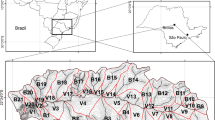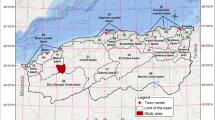Abstract
The ESAs (Environmentally sensitive areas) procedure was recently developed in the framework of MEDALUS European project to identify desertification-sensitive areas and used in many Mediterranean countries (Greece, Portugal, Italy, Egypt). The identification of areas sensitive to desertification by using the ESAs model was carried out in the Tusciano River basin (261 km2) located in southern Italy (Campania region). All data characterizing the four groups of parameters related to soil quality, climate quality, vegetation quality and management quality were introduced in a geographical database, and superimposed using a GIS. A sensitivity analysis highlighted the impact of desertification on the river Tusciano catchment, highly diversified in terms of morphological, geological, climatic and land use features. The results of the ESAs model, showing that more than half of the area is sensitive to desertification, were compared with those related to soil loss, achieved by Revised Universal Soil Loss Equation, based approximately on the same environmental factors. Nevertheless, ESAs procedure considers a wider range of parameters, allowing to characterize in greater detail the catchment in terms of climate, geomorphology, vegetation cover and socio-economic features. The drawn map therefore characterizes the sensitivity to erosion/desertification of the Tusciano catchment and can be regarded as a synthesis-sensitivity map, showing the areas with higher vulnerability on which mitigation measures should be focused.








Similar content being viewed by others
References
Basso F, Bove E, Dumontet S, Ferrara A, Pisante M, Quaranta G, Taberner M (2000) Evaluating environmental sensitivity at the basin scale through the use of geographic information systems and remotely sensed data: an example covering the Agri basin—Southern Italy. Catena 40:19–35
Carnemolla S, Drago A, Perciabosco M, Spinnato F (2001) Metodologia per la redazione di una carta in scala 1:250.000 sulle aree vulnerabili al rischio di desertificazione in Sicilia, Palermo (in Italian)
Ceccarelli T, Giordano F, Luise A, Perini L, Salvati L (2006) Vulnerability to desertification in Italy: collection, analysis, comparison, and validation of procedures for risk mapping and indicators used at national, regional and local scale. National Agency for Environmental Protection, Rome—Technical Report No. 40 2006 (in Italian)
Corniello A, Ducci D, Aquino A (2010) Hydrogeological map of the monti picentini regional park (southern Italy) at 1: 50.000 scale. Bollettino di Geofisica Teorica ed Applicata 51(4):325–343
Costantini EAC, Urbano F, Bonati G, Aramini G, Barbetti R, Bellino F, Bocci M, Bonati G, Fais A, L’abate G, Loj G, Magini S, Napoli R, Nino P, Paolanti M, Perciabosco M, Tascone F (2009) Rationale and methods for compiling an Atlas of desertification in Italy. Land Degrad Dev 20:261–276
Deichmann U, Eklundh L (1991) Global digital datasets for land degradation studies: a GIS approach. GRID base study series 4
De Martino G, De Paola F, Fontana N, Marini G, Ranucci A (2011a) Preliminary design of combined sewer overflows and stormwater tanks in southern Italy. Irrig Drain 60:544–555. doi:10.1002/ird.591
De Martino G, De Paola F, Fontana N, Marini G, Ranucci A (2011b) Pollution reduction in receivers: storm-water tanks. J Urban Plan Dev, ASCE, 137(1):29–38, ISSN 0733-9488/2011/1
De Martino G, De Paola F, Fontana N, Marini G, Ranucci A (2012) Experimental assessment of level pool routing in preliminary design of floodplain storage. Sci Total Environ. doi:10.1016/j.scitotenv.2011.11.032
De Paola F, Ranucci A (2012) Analysis of spatial variability for stormwater capture tanks assessment. Irrig Drain. doi:10.1002/ird.1675
De Paola F, Ducci D, Giugni M (2009) Definition of sensitive areas to desertification (Esas) in the river basin Tusciano. Poster Presentation. EGU General Assembly, vol 11
De Paola F, Ducci D, Giugni M (2011a) Definizione delle aree sensibili alla desertificazione (esas) nel bacino del fiume Tusciano. Polemio M (ed) 2011. Le modificazioni climatiche e rischi naturali. CNR IRPI, Bari, 9-12 (In Italian)
De Paola F, Giugni M, Ducci D (2011b) La definizione delle aree sensibili alla desertificazione (ESAs) nel bacino del fiume Tusciano, L’ACQUA, (5/2011), 9-24 (In Italian)
Di Gennaro A (2002) I sistemi di terre della Campania. Regione Campania, Risorsa srl, Assessorato alla Ricerca scientifica. Selca, Firenze, 2002 (in Italian)
Diodato N (2004) Estimating RUSLE’s rainfall factor in the part of Italy with a Mediterranean rainfall regime. Hydrol Earth Sys Sci 8:103–107
Dipace A, Baldassarre G (2005) Aree sensibili alla desertificazione nel Tavoliere di Puglia. Giornale di Geologia Applicata 2:203–209 (in Italian)
Ducci D, Tranfaglia G (2008) The effect of climate change on the hydrogeological resources in Campania region (Italy). In: Dragoni W (ed) Groundwater and climatic changes. vol 288, Geological Society, Special Publications, London, pp 25–38
Ducci D, Giugni M, Zampoli M (2007) Evaluation of soil erosion process of the Tusciano river basin. Book of the International Conference: Soil and Hillslope Management using scenario analysis and runoff-erosion models: a critical evaluation of current techniques COST 634, Florence (Italy), pp 30–36
Enne G, Zucca C (2000) Desertification indicators for the European Mediterranean region. State of the art and possible methodological approaches. Agenzia Nazionale per la Protezione dell’Ambiente, Rome, Italy
Ferrara A, Bellotti A, Faretta S, Mancino G, Baffari P, D’Ottavio A, Trivigno V (2005) Carta delle aree sensibili alla desertificazione della regione Basilicata. Forest 2(1):66–73 (in Italian)
Giugni M, Celico P, Fontana N, Lombardi G (2002) A proposed methodology for drawing up water protection plans. In: Proceedings of 2nd international conference new trends in water and environmental engineering for safety and life: ecocompatible solution for aquatic environments
Iavazzo P, Terracciano S, Topa ME, Adamo P, De Paola F, Giordano S, Giugni M (2012) Sensibilità alla desertificazione delle aree urbane e periurbane di Ouagadougou (Burkina Faso). Atti XXXIII Convegno nazionale di Idraulica e Costruzioni Idrauliche. Cosenza: Edibios, Brescia, 10-14 settembre 2012 (In Italian)
ISPRA (2008) Istituto Superiore Per La Protezione e la Ricerca Ambientale, Carta Geologica d’Italia alla scala 1:50.000–Foglio 468 Eboli. 2008 (in Italian)
Kosmas C, Ferrara A, Briassoulis H, Imeson A (1999) Methodology for mapping environmentally sensitive areas (ESAs) to desertification. In: Kosmas C, Kirkby M, Geeson N (eds) The Medalus project: Mediterranean desertification and land use. Manual on key indicators of desertification and mapping environmentally sensitive areas to desertification. European Union Report 18882, pp 31–47
Lo Gullo MA, Salleo SA (1988) Different strategies of drought resistance in three mediterranean sclerophyllous trees growing in the same environmental conditions. New Phytol 108:267–276
Mazzoleni S, Bellelli M, Esposito A, Ricotta C, Di Pasquale G, Blasi C (2001) Incendi e paesaggio vegetale: il caso del Cilento. Campania. L’Italia Forestale e Montana n. 6:417–429 (in Italian)
Motroni A, Canu S, Bianco G, Loj G (2004) Carta delle aree sensibili alla desertificazione (Environmentally Sensitive Areas to Desertification, ESAS). Servizio Agrometeorologico Regionale per la Sardegna, p 46 (in Italian)
Piro P, Carbone M, Frega F (2007) Identificazione di aree sensibili alla desertificazione (ESAs). Applicazione alla regione Calabria, L’Acqua 2:55–66 (in Italian)
Prasannakumar V, Shiny R, Geetha N, Vijith H (2011) Spatial prediction of soil erosion risk by remote sensing, GIS and RUSLE approach: a case study of Siruvani river watershed in Attapady valley, Kerala, India. Environ Earth Sci 64(4):965–972
Renard KG, Foster GR, Weesies GA, Porter PJ (1991) RUSLE—revised universal soil loss equation. J Soil Water Conserv, pp 30–33
Reynolds JF, Stafford Smith DM (2002) Global desertification: do humans cause deserts?, Dahlem University Press, Berlin, p 88
S.A.R. (2004) (Servizio Agrometeorologico Regionale per la Sardegna), Carta delle Aree Sensibili alla desertificazione, Environmentally Sensitive Area to Desertification ESAs, a cura di A. Motroni, S. Canu, G. Bianco, G. Loy
Sepehr A, Hassanli AM, Ekhtesasi MR, Jamali JB (2007) Quantitative assessment of desertification in south of Iran using MEDALUS method. Environment Monitoring Assessment, p 134
SESIRCA (2004) Settore sperimentazione informazione ricerca e consulenza in agricoltura della regione Campania, Carta dell’Utilizzazione Agricola dei Suoli della Campania (CUAS), Carta in scala 1/50.000 (in Italian)
SIMN (1959–1999) Presidenza del Consiglio dei Ministri, Servizi Tecnici Nazionali, Ufficio Idrografico e Mareografico di Napoli, Annali Idrologici. Istituto Poligrafico dello Stato (in Italian)
Stone RP, Hilborne D (2000) Universal soil loss equation. Ministry of agriculture, food and rural affairs, p 8. http://www.omafra.gov.on.ca/english/engineer/facts/00-001.htm
United Nations Convention to Combat Desertification, National Report of Italy on the Implementation of the UNCCD, 2000, p 52. http://www.unccd.int/cop/reports/northmed/national/2000/italy-eng.pdf
USDA (1999) United states department of agriculture, national resources conservation service, soil taxonomy: A basic system of soil classification for making and interpreting soil surveys (2nd edn). USDANRCS. Agricultural Handbook 436, US Gov. Print. Office: Washington, DC
Veron SR, Paruelo JM, Oesterheld M (2006) Assessing desertification. J Arid Environ 66:751–763
Zampoli M (2007) I processi di erosione del suolo: un’analisi a scala di bacino, PhD Thesis in Valutazione e Mitigazione del Rischio Ambientale, University of Naples Federico II, p 181 http://www.fedoa.unina.it/2707/, 2007 (in Italian)
Author information
Authors and Affiliations
Corresponding author
Electronic supplementary material
Below is the link to the electronic supplementary material.
Rights and permissions
About this article
Cite this article
De Paola, F., Ducci, D. & Giugni, M. Desertification and erosion sensitivity. A case study in southern Italy: the Tusciano River catchment. Environ Earth Sci 70, 2179–2190 (2013). https://doi.org/10.1007/s12665-013-2294-2
Received:
Accepted:
Published:
Issue Date:
DOI: https://doi.org/10.1007/s12665-013-2294-2




